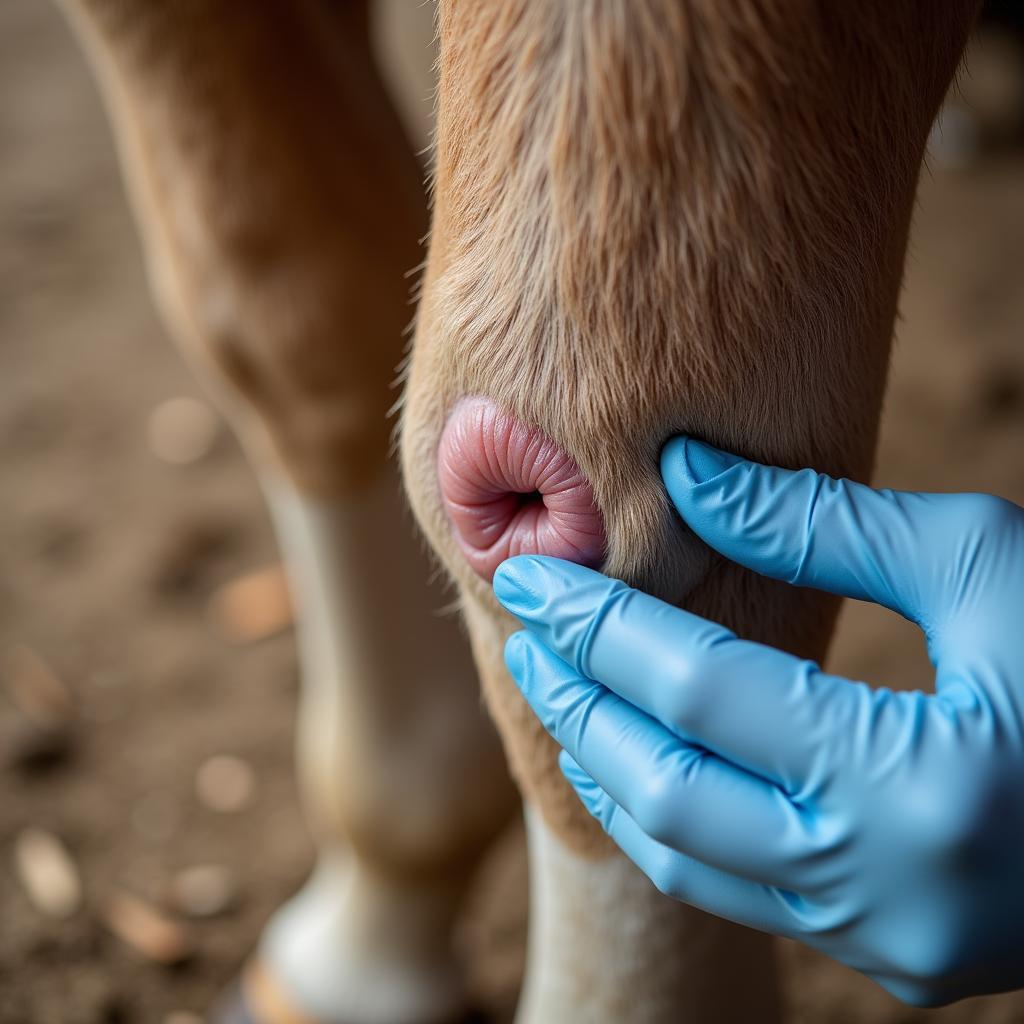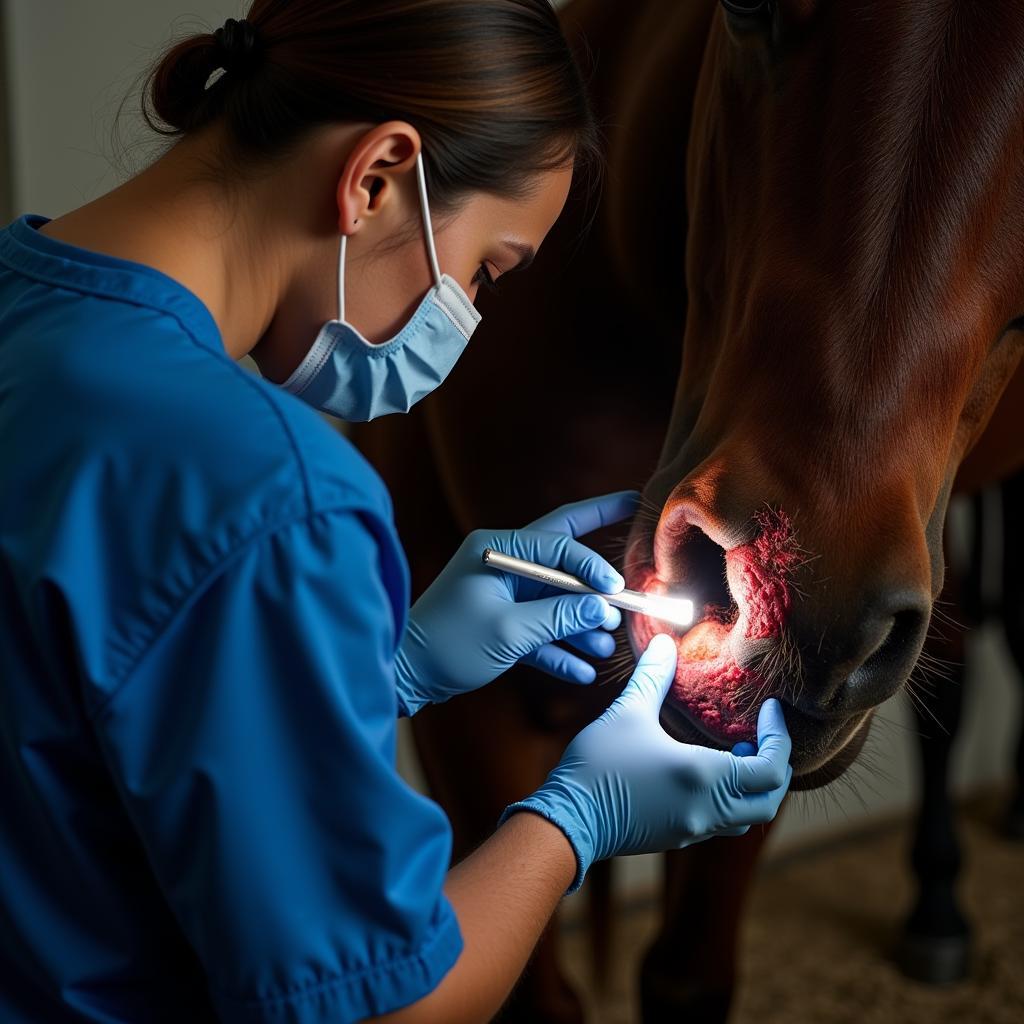Silver sulfadiazine, more commonly known as SSD, is a topical medication often found in equine first aid kits. But what exactly is Ssd For Horses, and when should it be used? This comprehensive guide will delve into the uses, benefits, and potential risks of SSD for your equine companion.
What is SSD and How Does it Work?
SSD is a broad-spectrum antimicrobial agent that effectively combats a range of bacteria and some fungi. It works by disrupting the cell walls of these microorganisms, preventing their growth and multiplication. While it’s not a cure-all, SSD plays a crucial role in managing infections and promoting healing in horses.
Uses of SSD for Horses
SSD for horses is a versatile treatment option for various skin conditions, including:
- Minor Wounds and Abrasions: SSD can help prevent infections in superficial wounds like cuts, scrapes, and abrasions.
- Burns: Its soothing properties can ease pain and inflammation associated with minor burns.
- Rain Rot and Scratches: SSD can be effective in managing bacterial and fungal infections commonly seen in these conditions.
- Post-Surgical Care: Veterinarians may recommend SSD to aid in wound healing after surgical procedures.
 Applying SSD Cream to Horse Leg
Applying SSD Cream to Horse Leg
Benefits of Using SSD for Horses
- Broad-Spectrum Activity: Effective against a wide range of bacteria and some fungi.
- Topical Application: Minimally invasive, reducing the need for oral medications or injections.
- Promotes Healing: Helps create a barrier against infection, allowing the wound to heal faster.
- Reduces Inflammation: Can soothe irritated skin and reduce swelling.
Applying SSD to Your Horse: A Step-by-Step Guide
- Clean the Affected Area: Gently clean the wound or affected area with mild soap and water.
- Dry Thoroughly: Pat the area dry with a clean towel. Moisture can hinder the effectiveness of SSD and promote bacterial growth.
- Apply a Thin Layer: Using a gloved hand or a clean cotton swab, apply a thin layer of SSD cream to the affected area.
- Repeat as Directed: Follow your veterinarian’s instructions on how often to apply the medication.
- Monitor for Improvement: Keep a close eye on the wound for signs of improvement or potential adverse reactions.
Potential Side Effects and Precautions
While SSD is generally safe for horses, it’s important to be aware of potential side effects and take necessary precautions:
- Allergic Reactions: Some horses may experience allergic reactions to SSD, resulting in redness, itching, or swelling.
- Sun Sensitivity: SSD can increase a horse’s sensitivity to sunlight. Keep treated areas covered or stabled during peak sun hours.
- Staining: SSD can temporarily stain light-colored hair or clothing.
 Veterinarian Examining Horse Wound
Veterinarian Examining Horse Wound
When to Consult Your Veterinarian
It’s crucial to remember that SSD is not a substitute for professional veterinary care. While it can be beneficial for minor wounds, seeking veterinary advice is essential for:
- Deep Wounds: Wounds requiring stitches or other forms of closure.
- Infected Wounds: Wounds showing signs of infection like pus, foul odor, or excessive heat.
- Wounds Not Healing: Wounds that aren’t showing signs of improvement after a few days of treatment.
SSD: A Valuable Tool in Your Equine First Aid Kit
Understanding how and when to use SSD can empower horse owners to provide immediate care for minor wounds and skin conditions. However, always prioritize your horse’s well-being by consulting your veterinarian for any concerns or questions regarding your horse’s health.
For more in-depth information on wound care and using SSD ointment for horses, visit our detailed guide: ssd ointment for horses
Frequently Asked Questions about SSD for Horses
Q1: Can I use human SSD cream on my horse?
While the active ingredient is the same, it’s always best to use medications specifically formulated for horses to ensure the correct dosage and avoid potential additives that could harm your horse.
Q2: How long does it take for SSD to work on a horse?
Improvement in the wound or skin condition is typically observed within a few days of consistent SSD application. However, complete healing time varies depending on the severity and type of injury.
Q3: Can SSD be used on open wounds?
Yes, SSD is generally safe for use on open wounds and can help prevent infection. However, it’s essential to consult your veterinarian for the appropriate wound care regimen.
Q4: How should I store SSD cream?
Store SSD cream in a cool, dry place, away from direct sunlight and heat. Make sure it’s out of reach of children and animals.
Q5: What should I do if my horse licks the SSD?
While small amounts of SSD are unlikely to cause serious harm, it’s best to prevent your horse from licking the treated area. You can use a taste deterrent or a bandage to discourage licking.
For any urgent concerns or if you suspect your horse requires immediate medical attention, please don’t hesitate to contact us:
Phone Number: 0772127271
Email: [email protected]
Address: QGM2+WX2, Vị Trung, Vị Thuỷ, Hậu Giang, Việt Nam
Our dedicated customer support team is available 24/7 to assist you and answer any questions you may have.